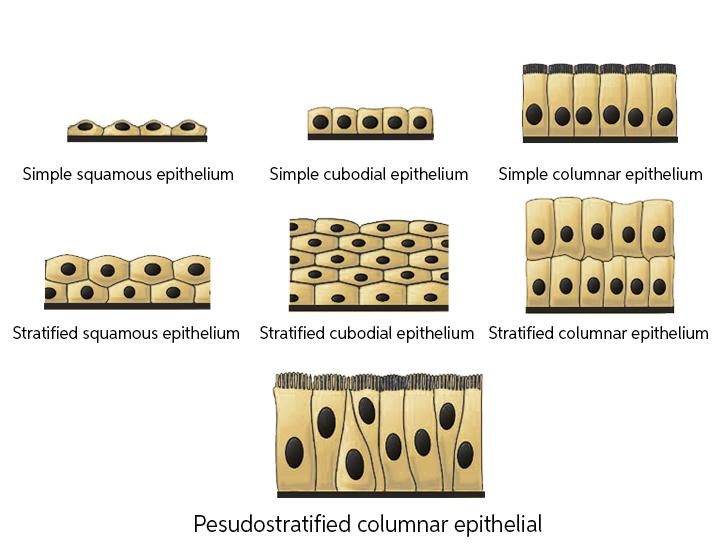Answer
393.9k+ views
Hint: The epithelial tissue consists of cells with tight cell-to-cell attachments spread out in sheets. In epithelia, the cell turnover that is the continuous shedding of dead cells with the replacement of younger cells is very rapid.
Complete answer:
The main characteristic of epithelial tissues is cells can be subjected to rapid division. Epithelial tissue is abundant all over the body. They form the covering of all surfaces of the body, line cavities of the body, and hollow organs and are the main tissue in glands. Glands subdivided as exocrine and endocrine are composed of epithelial tissue. Cells are densely packed with minimal intercellular substance. The cells have one free surface that is not in contact with other cells because the tissues form coverings and linings. The avascular sense of epithelial tissue is that they lack their blood vessels. Exchange of nutrients and waste occurs by diffusion through the surrounding connective tissues.

Figure: Different types of Epithelial tissue
So the correct answer is ‘Cells can undergo rapid divisions’.
Additional Information:
Epithelial tissues conduct several functions including defense, secretion, absorption, diffusion, filtration, excretion, and sensory reception. Epithelial tissue is simply classified into two categories such as simple epithelium and stratified epithelium. When the tissue is made up of a single layer of cells it is called simple epithelium whereas tissue with two or more layers is called the stratified epithelium.
Note: - Epithelial tissues provide first-line protection for the body against physical, chemical, and biological wear and tear.
- The epithelium cells serve as the body's gatekeepers regulating permeability and enabling materials to be selectively moved over a physical obstacle.
Complete answer:
The main characteristic of epithelial tissues is cells can be subjected to rapid division. Epithelial tissue is abundant all over the body. They form the covering of all surfaces of the body, line cavities of the body, and hollow organs and are the main tissue in glands. Glands subdivided as exocrine and endocrine are composed of epithelial tissue. Cells are densely packed with minimal intercellular substance. The cells have one free surface that is not in contact with other cells because the tissues form coverings and linings. The avascular sense of epithelial tissue is that they lack their blood vessels. Exchange of nutrients and waste occurs by diffusion through the surrounding connective tissues.

Figure: Different types of Epithelial tissue
So the correct answer is ‘Cells can undergo rapid divisions’.
Additional Information:
Epithelial tissues conduct several functions including defense, secretion, absorption, diffusion, filtration, excretion, and sensory reception. Epithelial tissue is simply classified into two categories such as simple epithelium and stratified epithelium. When the tissue is made up of a single layer of cells it is called simple epithelium whereas tissue with two or more layers is called the stratified epithelium.
Note: - Epithelial tissues provide first-line protection for the body against physical, chemical, and biological wear and tear.
- The epithelium cells serve as the body's gatekeepers regulating permeability and enabling materials to be selectively moved over a physical obstacle.
Recently Updated Pages
How do you arrange NH4 + BF3 H2O C2H2 in increasing class 11 chemistry CBSE

Is H mCT and q mCT the same thing If so which is more class 11 chemistry CBSE

What are the possible quantum number for the last outermost class 11 chemistry CBSE

Is C2 paramagnetic or diamagnetic class 11 chemistry CBSE

What happens when entropy reaches maximum class 11 chemistry JEE_Main

Calculate the volume occupied by 88 gram of CO2 at class 11 chemistry CBSE

Trending doubts
State the differences between manure and fertilize class 8 biology CBSE

Why are xylem and phloem called complex tissues aBoth class 11 biology CBSE

Difference between Prokaryotic cell and Eukaryotic class 11 biology CBSE

Difference Between Plant Cell and Animal Cell

What would happen if plasma membrane ruptures or breaks class 11 biology CBSE

Give 10 examples for herbs , shrubs , climbers , creepers

What precautions do you take while observing the nucleus class 11 biology CBSE

What would happen to the life of a cell if there was class 11 biology CBSE

Change the following sentences into negative and interrogative class 10 english CBSE



